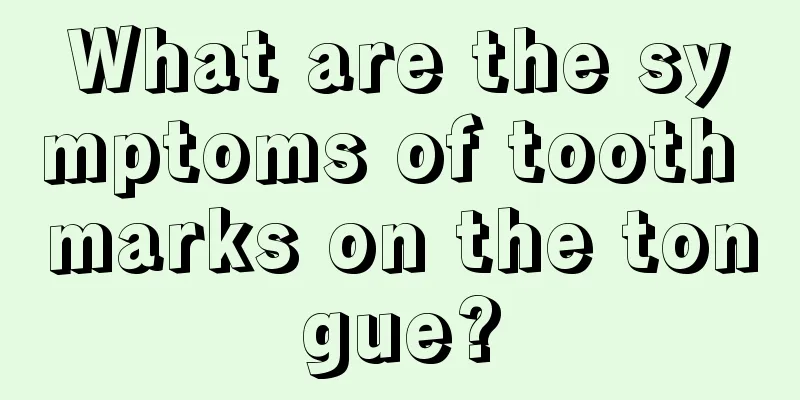What are the symptoms of tooth marks on the tongue?

|
In daily life, many people will find tooth marks on their tongue, which is called tooth marks in traditional Chinese medicine. It is usually caused by physical weakness, which can easily cause the tongue to be slightly larger, making it easier to touch the teeth and leaving tooth marks. Weak spleen and kidney or kidney deficiency can also easily lead to tooth marks on the tongue, which requires timely treatment. What causes tooth marks on tongue? Traditional Chinese medicine calls it "tooth marks on the tongue", which is a typical symptom of qi deficiency. When the human body is deficient in qi, the tongue will be slightly swollen, which is not easy to distinguish with the naked eye. However, by observing the edge of the tongue, you can see traces of teeth, which is the same as the depression that occurs when pressing down on swollen limbs. When Qi deficiency is severe, the tongue may even swell to fill the entire mouth, or become difficult to retract and stretch. Tooth marks on the tongue are generally related to the spleen and kidneys. Spleen deficiency can cause phlegm and dampness, which is mainly caused by greasy diet, too cold diet, etc. Kidney deficiency can cause kidney-related symptoms such as soreness in the waist and knees. However, the spleen and kidneys influence each other, and in many cases, qi deficiency occurs at the same time. You don't have any other symptoms now, which means it's just a slight imbalance, which can be eliminated through exercise and diet control. Clinical manifestations Pale white, moist and with tooth marks, it indicates excessive cold and dampness; Pale red with tooth marks, it indicates spleen deficiency or qi deficiency; Red and swollen mouth with teeth marks on the edges, mostly due to damp heat and phlegm stagnation; In short, it can be divided into two types: Qi deficiency and Yang deficiency: ⑴ Qi deficiency type: weak spleen, main symptoms: pale tongue, thin white tongue coating, plump and tender tongue, tooth marks on the edges of the tongue, pale or yellowish complexion, shortness of breath and laziness to speak, heavy head and swollen body, fatigue, spontaneous sweating, decreased appetite, abdominal distension after eating, nausea and vomiting, loose stools, and weak pulse. Treatment principle: tonify the middle and replenish Qi. ⑵ Yang deficiency type: Main symptoms: pale tongue, moist and slippery tongue surface, round, plump and tender tongue with teeth marks on the edges. Pale or dark complexion, fatigue, lethargy and love of lying down, bland mouth without thirst, poor appetite, cold pain in the abdomen, relieved by warmth, cold stomach and limbs, clear urine and loose stools, or edema, and a deep and weak pulse. Treatment principle: spicy and warm to tonify Yang. examine Microcirculatory changes Microcirculation research Qian Xinru et al. used the method of tongue fungiform papilla counting and tongue tip microcirculation to study the blood supply and nutritional status of the concave and convex areas of the spur-marked tongue, and compared them with the normal pink tongue. They found that the microcirculation changes of the spur-marked tongue have the following aspects: ⑴ Blood supply disorder. The microvascular plexus of the fungiform papillae is reduced, and the arterial arm of the capillary is thinner than the venous arm. These two manifestations are particularly obvious in the convex part of the scalloped tongue. The amount of atypical microvascular plexus is increased compared to normal. ⑵ Local hypoxia and malnutrition. The number of fungiform papillae on the tongue is positively correlated with blood supply, and the number of fungiform papillae on the tongue with tooth marks is lower than that on normal people. ⑶Tissue edema. The diameter of the fungiform papillae of the serrated tongue is significantly larger than normal, which is caused by water retention in the lamina propria tissue inside the papilla. Yu Fangting used a microcirculation microscope to observe the microcirculation of the tongue tip in patients with uremia and kidney yang deficiency before and after the same hemodialysis. Before dialysis, 108 out of 125 patients had enlarged tongues with tooth marks. After dialysis, the degree of tongue enlargement and tooth marks was slightly reduced. The microcirculation of the tongue tip shows blurred microvascular loops and exudation in the lingual papillae. After hemodialysis ultrafiltration (dehydration), the loops are clearer and the exudation is reduced. Therefore, the exudation of the lingual microvascular loops is one of the reasons for the enlarged tongue with tooth marks. Pathological changes Pathological research Qian also used optical microscopy and electron microscopy to compare and examine the tissue and cell morphology of the convex and concave parts of the spur-marked tongue and the normal tongue edge, and believed that the main pathological changes of the spur-marked tongue are: ⑴ Thinning of the epithelial layer. The epithelial layer is thickest in the normal tongue, followed by the concave part, and thinnest in the convex part, which may be related to local nutritional status; ⑵ Changes in the rough endoplasmic reticulum. In the basal layer and spinous cell layer, the rough endoplasmic reticulum is reduced, expanded, and ribosomes are lost. These manifestations indicate dysfunction of rough endoplasmic reticulum protein synthesis, which is one of the manifestations of cell damage; ⑶ tension filaments are reduced. The tension filaments of the scalloped tongue are reduced, the intercellular spaces between the spinous cells and the basal layer are enlarged and present a sparse mesh-like shape, and the desmosomes of the digital papillae are reduced, indicating that the cells of the scalloped tongue are poorly connected;⑷ Edema of the cell tissue. It is mainly due to local lack of nutrition that increases the permeability of cell membranes, causing water to overflow from blood vessels and penetrate into cells. On the other hand, lymphatic return is poor and cannot carry away excess water; ⑸ Lack of elastic fiber. The lack of this fiber reduces the tolerance to pulling, so it becomes jagged due to the pressure of the teeth. |
<<: What are the symptoms of autumn diarrhea and how to treat it?
>>: What are the symptoms of vitamin C deficiency
Recommend
How to make pickled mango
Mango is a tropical fruit. Most of the time, peop...
What is Hip Impingement Syndrome
Many patients are told that they suffer from hip ...
People should be more careful about the causes of kidney cancer in life
Kidney cancer is a cancer that scares us a lot, a...
Is cherry the fruit of cherry blossoms?
Cherry and cherry blossom are two different plant...
What can I use to wash grapes cleanly
Grapes are a popular fruit. In our country, Xinji...
What are the early symptoms of colon cancer
Transverse colon cancer is rare and easy to misdi...
Is it reliable to use a microwave to disinfect?
The emergence of microwave ovens has allowed more...
How to repair black and broken front teeth
Dental health directly affects our oral health. O...
What to do if diastolic blood pressure is too high
Hypertension is a disease that usually occurs in ...
Why are my feet swollen when I wake up in the morning?
After working during the day, the human body will...
What is the function of pubic hair?
When they reach a certain age, both men and women...
What to eat and what not to eat if you have high cholesterol
If you consume too much food containing cholester...
Radish can cure gout. Radish is very effective in treating gout
I believe everyone is familiar with radish. It is...
How to clean vulvar itching?
The vulva is the external tissue of the female re...
Lustful men should be careful to prevent prostate cancer from coming to you
The onset of prostate cancer is definitely closel...









